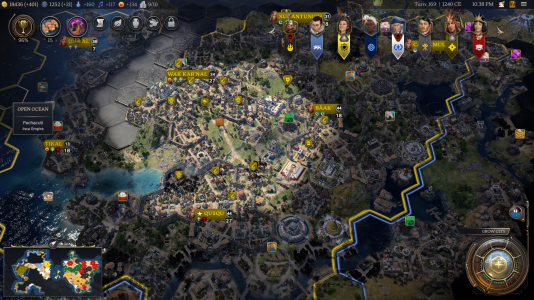Yeah, Fishing Boats usually produce more food than Farms, which works against having lots of farmland. That doesn't seem like it should be the case.
Farms can be boosted by more things than Fishing Boats, though, so their potential is much higher. In the game I just finished, the highest yield on Fishing Boats that I had was 5, and my Farm tiles were mostly more in the 5-8 range. It balances out a bit, though, because Fishing Boats are a thing you'll keep around even in a heavily urbanized coastal town, just because there are very few urban districts that you can place on coastal tiles. You'll have one coastal tile with a Fishing Quay and a Wharf/Port, and that's about it unless you build a coastal wonder.
Regarding the question of whether settlements have too much urban sprawl: I think people haven't yet quite wrapped their heads around the whole concept of Towns yet. Cities, for the most part, do tend to urbanize over time until the only rural tiles left are resources (which you can't build over with urban districts). And I think that progression is intentional, and makes sense thematically. Look at a large city like New York--how much rural space and farmland is there is New York City, including the boroughs? Basically none, unless you could parks. Any city in Civ VII that grows enough is going to eventually turn into to that sort of metropolis.
But Civ VII doesn't want you to just build cities. They have the new town mechanic, and while I know they originally pitched it as a mechanic that reduces micromanagement, and a lot of people seem to think of towns as either a temporary state until you get around to turning that settlement into a city, I think there's a pretty good argument to be made for building towns that you intend to
keep as towns for the entire game, regardless of whether you are playing tall or wide. Towns have the capability to support cities in a way that supercharges their growth and development, and the way that cities urbanize is part of that, because over time most cities lose a lot of their food production and growth slows almost to a halt. And growth is important, even in cities that have no more claimable tiles, because: Specialists.
As an example, here is my trio of Nekhen/Waset/Gangaikonda Cholapuram in the modern age (Nekhen is just to the southwest). These three cities have grown together into a gigantic megalopolis, and the only rural tiles that any of them have at this point are resource tiles.
All three of these cities are still growing at a good pace. Let's look at Waset and see why:
That's 243.2 food per turn. Of that, only 11.8 food comes from Waset itself. The rest come from the various towns that surround this megalopolis, like Meroe, which is just to the west of Waset:
Meroe is a farming town. I intentionally established it as a farming town and will never convert it to a city, because Waset needs Meroe to be a farming town in order to grow. Meroe does have two urban quarters, to accommodate some warehouse buildings--Granary, Grocer, etc.--and that's all the urbanization it needs. I have other farming towns feeding Nekhen and Gangaikonda Cholapuram, and I have some mining towns that are giving me a
lot of gold per turn. And some trading towns, and various other things. There are a bunch of useful town specializations.
My point is, if you are converting all of your settlements to cities, you are leaving a lot of potential growth and production on the table. Civ VII really wants you to build a variety of settlements--a mix of cities and towns that support those cities. Some settlements will be urban sprawl, some of them will be idyllic farming communities, some will be ugly industrial towns--there's a lot of variety.
So ultimately, no--you don't lose all of your rural tiles over the course of the game. They do get pushed to the outskirts of your major cities over time, and I think that does a pretty good job mirroring what happens in real life.








